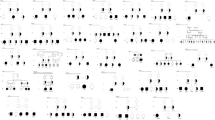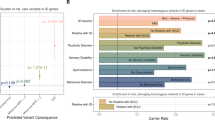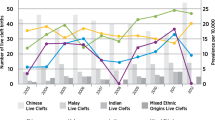Abstract
Infants born with birth defects have poorer outcomes in terms of mortality and disability, but the long-term intellectual outcome in children with birth defects is generally unknown. We assessed the long-term associations of various birth defects with mortality and disability, and evaluated whether high mortality and disability were reflected in impaired intellectual performance at age 18. In this nationwide cohort study, records of 9,186 males with and 384,384 without birth defects, registered in the Medical Birth Registry of Norway (1967–1979) were linked to the National Conscript Service (1984–1999). Mortality and disability before military draft, and intelligence test score at conscription were the main outcome measures. Males with birth defects had a relative risk for disability of 6.0 compared with males without defects. Disability was low within categories of birth defects associated with low mortality, and high within defect categories associated with high mortality. The relative risk for not being drafted was highest if maternal educational level was low. Heart defects and cleft palate were the only subgroups in which intellectual performance was lower after adjustment for maternal education, maternal age, marital status and birth order. In particular, intellectual performance was not impaired among those with multiple compared with single defects. We conclude that for the majority of birth defect categories in the present birth cohort, our hypothesis that intellectual performance would be impaired was not confirmed. Thus, there seems to be little reason to fear an adverse intellectual outcome in non-disabled surviving infants with birth defects.
Similar content being viewed by others
Log in or create a free account to read this content
Gain free access to this article, as well as selected content from this journal and more on nature.com
or
Abbreviations
- ICD-8:
-
International Classification of Diseases 8th Revision
- NHIO:
-
National Health Insurance Office
- OR:
-
odds ratio
- RR:
-
relative risk
References
Skjærven R, Wilcox AJ, Lie RT 1999 A population-based study of survival and childbearing among female subjects with birth defects and the risk of recurrence in their children. N Engl J Med 340: 1057–1062
Mitchell LE 1997 Genetic epidemiology of birth defects: nonsyndromic cleft lip and neural tube defects. Epidemiol Rev 19: 61–68
Melve KK, Skjærven R 2002 Families with birth defects: is birth weight of nonmalformed siblings affected?. Am J Epidemiol 155: 932–940
Lie RT, Wilcox AJ, Skjærven R 2001 Survival and reproduction among males with birth defects and risk of recurrence in their children. JAMA 285: 755–760
Vrijheid M, Dolk H, Stone D, Abramsky L, Alberman E, Scott JE 2000 Socioeconomic inequalities in risk of congenital anomaly. Arch Dis Child 82: 349–352
Batty GD, Deary IJ 2004 Early life intelligence and adult health. BMJ 329: 585–586
Osler M, Batty GD 2004 Commentary: influence of early life intelligence test performance on later health: do lower scoring children become less healthy adults?. Int J Epidemiol 33: 414–415
Kuh D, Richards M, Hardy R, Butterworth S, Wadsworth ME 2004 Childhood cognitive ability and deaths up until middle age: a post-war birth cohort study. Int J Epidemiol 33: 408–413
Whalley LJ, Deary IJ 2001 Longitudinal cohort study of childhood IQ and survival up to age 76. BMJ 322: 819–
Griffin KJ, Elkin TD, Smith CJ 2003 Academic outcomes in children with congenital heart disease. Clin Pediatr (Phila) 42: 401–409
Nopoulos P, Berg S, VanDemark D, Richman L, Canady J, Andreasen NC 2002 Cognitive dysfunction in adult males with non-syndromic clefts of the lip and/or palate. Neuropsychologia 40: 2178–2184
Iddon JL, Morgan DJ, Loveday C, Sahakian BJ, Pickard JD 2004 Neuropsychological profile of young adults with spina bifida with or without hydrocephalus. J Neurol Neurosurg Psychiatry 75: 1112–1118
Irgens LM 2000 The Medical Birth Registry of Norway. Epidemiological research and surveillance throughout 30 years. Acta Obstet Gynecol Scand 79: 435–439
Sundet JM, Barlaug D, Torjussen T 2004 The end of the Flynn Effect? A study of secular trends in mean intelligence test scores of Norwegian conscripts during half a century. Intelligence 32: 349–362
Eide M, Øyen N, Skjærven R, Nilsen ST, Bjerkedal T, Tell GS 2005 Size at birth and gestational age as predictors of adult height and weight. Epidemiology 16: 175–181
Sundet JM, Tambs K, Magnus P, Berg K 1988 On the question of secular trends in the heritability of IQ test scores: a study of Norwegian twins. Intelligence 12: 47–59
Tambs K, Sundet JM, Magnus P, Berg K 1989 Genetic and environmental contributions to the covariance between occupational status, educational attainment, and IQ: a study of twins. Behav Genet 19: 209–222
Christensen K, Juel K, Herskind AM, Murray JC 2004 Long term follow up study of survival associated with cleft lip and palate at birth. BMJ 328: 1405
Hunt GM, Oakeshott P 2003 Outcome in people with open spina bifida at age 35: prospective community based cohort study. BMJ 326: 1365–1366
Basso O, Olsen J, Christensen K 1999 Recurrence risk of congenital anomalies–the impact of paternal, social, and environmental factors: a population-based study in Denmark. Am J Epidemiol 150: 598–604
Kalter H, Warkany J 1983 Medical progress. Congenital malformations: etiologic factors and their role in prevention (first of two parts). N Engl J Med 308: 424–431
Lie RT, Heuch I, Irgens LM 1994 Maximum likelihood estimation of the proportion of congenital malformations using double registration systems. Biometrics 50: 433–444
Wray J, Sensky T 2001 Congenital heart disease and cardiac surgery in childhood: effects on cognitive function and academic ability. Heart 85: 687–691
Limperopoulos C, Majnemer A, Shevell MI, Rohlicek C, Rosenblatt B, Tchervenkov C, Darwish HZ 2002 Predictors of developmental disabilities after open heart surgery in young children with congenital heart defects. J Pediatr 141: 51–58
Rimoin D, Connor J, Pyeritz R, Korf B 2002 Emery and Rimoin's Principles and Practice of Medical Genetics. 4th ed. Vol. 1. Churchill Livingstone, London, New York,
Swanenburg de Veye HF, Beemer FA, Mellenbergh GJ, Wolters WH, Heineman-de Boer JA 2003 An investigation of the relationship between associated congenital malformations and the mental and psychomotor development of children with clefts. Cleft Palate Craniofac J 40: 297–303
Speltz ML, Endriga MC, Hill S, Maris CL, Jones K, Omnell ML 2000 Cognitive and psychomotor development of infants with orofacial clefts. J Pediatr Psychol 25: 185–190
Kallen B, Harris J, Robert E 1996 The epidemiology of orofacial clefts. 2. Associated malformations. J Craniofac Genet Dev Biol 16: 242–248
Berseth CL, Malachowski N, Cohn RB, Sunshine P 1982 Longitudinal growth and late morbidity of survivors of gastroschisis and omphalocele. J Pediatr Gastroenterol Nutr 1: 375–379
Acknowledgements
We thank John Ivar Brevik and his staff at the Norwegian Conscripts Service for help in collecting the data from the draft examination, Ola Thune for technical assistance, and Grethe S. Tell and David Batty for helpful comments on previous versions of the manuscript.
Author information
Authors and Affiliations
Corresponding author
Additional information
This work was funded by the Norwegian Research Council grant no. 129248/330, and supported by a grant from the Western Norway Regional Health Authority.
Rights and permissions
About this article
Cite this article
Eide, M., Skjærven, R., Irgens, L. et al. Associations of Birth Defects with Adult Intellectual Performance, Disability and Mortality: Population-based Cohort Study. Pediatr Res 59, 848–853 (2006). https://doi.org/10.1203/01.pdr.0000219172.16638.f9
Received:
Accepted:
Issue date:
DOI: https://doi.org/10.1203/01.pdr.0000219172.16638.f9
This article is cited by
-
Childhood disability and its associated perinatal characteristics in Bao’an district of Shenzhen, China
BMC Public Health (2020)
-
Parental and health care professional views on psychosocial and educational outcomes in patients with cleft lip and/or cleft palate
European Journal of Plastic Surgery (2019)



